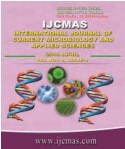


 National Academy of Agricultural Sciences (NAAS)
National Academy of Agricultural Sciences (NAAS)

|
PRINT ISSN : 2319-7692
Online ISSN : 2319-7706 Issues : 12 per year Publisher : Excellent Publishers Email : editorijcmas@gmail.com / submit@ijcmas.com Editor-in-chief: Dr.M.Prakash Index Copernicus ICV 2018: 95.39 NAAS RATING 2020: 5.38 |
Field experiments were conducted during the year 2013-14and 2014-15 in an Aquic Hapludoll at D7 block of Norman E. Borlouge Crop Research Centre of G.B. Pant University of Agriculture and Technology, Pantnagar (290 N latitude and 79029’ E longitude). To fulfill the objectives of the present investigation two experiments were conducted in the year 2013-14 and 2014-15. In first phase fodder Sorghum (var. Pant Chari-7) was taken as an exhaust crop and in second phase i.e. next season test crop Marigold (var. Pusa Narangi) was grown by dividing each strip in 24 plots having 21 treatments and 3 controlled plots. Response to selected combinations of three levels of FYM (0, 5 and 10 t ha-1), four levels of nitrogen (0, 60, 120 and 180 kg ha-1), four levels of Phosphorus (0, 30, 60 and 90 kgP2O5 ha-1) and four levels of potassium (0, 30, 60 and 90 kg K2O ha-1) for Marigold. The nutrient requirement for production of one quintal flower yield was 1.06, 0.34 and 1.32kg for nitrogen, phosphorus and potassium respectively. Contribution of nitrogen, phosphorus and potassium from soil for marigold was 26.23, 54.03 and 42.02. Contribution from fertilizer with FYM for marigold was 98.35, 40.25 and 168.68 Percent contribution of nutrient from fertilizer without FYM for marigold was 83.25, 38.96 and 168.91respectively. Contribution of nutrient from FYM for marigold was 46.81, 61.30 and 128.4 % Fertilizer adjustment equations for targeted yield of Marigold were developed with and without FYM with the help of basic data. Coefficient of multiple regression (R2) was found to be highly significant in case of marigold (0.473**) between grain yield, soil test values, added fertilizers, and interaction between added soil and fertilizers. Verification trials were conducted to test the validity of fertilizer adjustment equations and fertilizer application based on targeted yield approach was found to be superior over general recommended dose (GRD). Among different methods, organic C, Mehlich-1 P and neutral normal ammonium acetate-K can be taken as indices for determining N, P and K in Mollisol of Uttarakhand. Treatment T9 and T5was found to be as balanced fertilizer treatments in terms of yield of marigold. Findings from present study can successfully be utilized for the larger parts of Tarai region of Uttarakhand as effective guide for efficient and balanced fertilizer recommendation.
 |
 |
 |
 |
 |